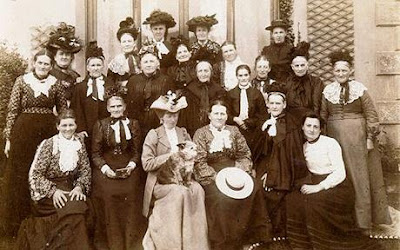To fully appreciate the whats and whys of the twenties, you have to understand where it came from. Just eight years prior was the sinking of the Titanic. Tragic event, but an easy one for remembering what the 1910s gave us.
Women were still wearing corsets, long skirts, and big hats to compliment their long hair.
James Cameron's movie "Titanic" is a great resource for fashion of the era. Men were pretty straight forward with their fashion: three piece suits that meant business. Not unlike modern suits, though with a different collar.
Then World War I came and went and things began to shift. After the war, women started entering the workforce in earnest and the economy was feeling like gangbusters. Aside from the whole prohibition of alcohol thing, people were really enjoying life. Technology was booming, and with the modernizing of everyday things came the overhaul of traditions.
Whereas the silhouette of the '10s was an S curve (busty, butt...ie), the silhouette of the '20s was a completely opposite boyish look.
The waist was dropped, the hemline raised, the hairline raised, the chest and hips flattened, and the hats small. Coincidentally, it wasn't until around this time that women started shaving their legs. The skirts were often pleated or full, to allow greater movement for the dances of the day (like the Charleston).
Enter The Flapper. Made popular by the 1920 film of the same name, the term embodies a new and radical way of living. Flappers were rebellion personified. When most people think of a Flapper, they think of this dress here:
Though this does pass for a modern take on the Flappers of that decade, dresses like this were not the only thing they wore. Expand your horizons; keep in mind the shorter (sometimes asymmetrical) hems and boyish shape and still be a Flapper without looking like everyone else.
Clothing for men became more relaxed, though honestly not a lot changed.
Many people think that the dress for men of the '20s was a pinstriped zoot suit, or gangster suit, like this one:
When really that kind of exaggerated fashion didn't come about until the late 1930s, early '40s. A woman wearing a flapper dress together with a man wearing a zoot suit would have been as awkward as a man wearing MC Hammer pants to the prom in '95.
Which brings me to the 1930s! Think shoulder pads, lovely, lovely shoulder pads. Hemlines started going back down while waists went back up. Hair was eventually grown longer again.
Suits for men became baggier, then eventually the most daring wore the zoot suit. Unlike the '20s which was prospering because of the war, the '30s were being dragged down by the great depression. Though clothing was still beautiful, it seems (to me) to have a more somber attitude. Here is a picture taken from the early 1930s of my very own grandparents.
My favorite part is her bangs.
The next time you're invited to a '30s party, chances are they mean '20s. And you can slyly smile to yourself for knowing the difference.













Flappers and gangster suits I admire so much. I love to dress-up and hit the town whenever I feel like it.
ReplyDeleteAs you should! I think people have grown to fear dressing up, both in modern day fancy clothing, and in costume. We're all so casual now.
ReplyDeleteI am a flapper for Halloween and my dress actually resembles a lot of these pictures!!
ReplyDelete